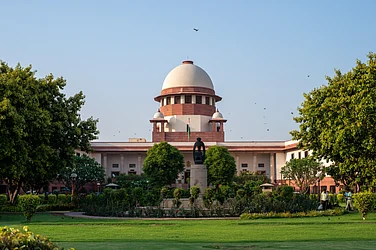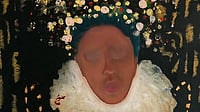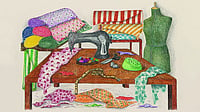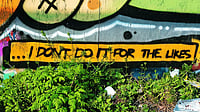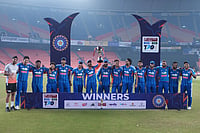Guzashtim-o-guzashtim-o-budani hame bud
Shudim-o-shud sukhan-e ma fasana-e atfal
We left it all behind, and off we went; what was fated, came to pass.
We were done, and our doings became tales for the children.
—Kis’ ai Marwazi
My mother was born in the winter of 1952 in Srinagar on a snowy day to a vibrant couple, Prakash and Aroo Soni. As a pair, they were known in the valley as Mr. and Mrs. Preco, after the photo studio which my grandfather ran for many decades, even trying to keep it running during the difficult ’90s. It was the time of black and white photography, and as my aunt tells me, he spent much time touching the lips and cheeks of tourists who wanted their photographs to be taken in Kashmiri costume. He was known for his portraits; one can see them scattered all over Kashmir. He also travelled extensively, covering the landscapes of Gulmarg and Pahalgam and other far reaches. He took photographs for the tourism department, many of which can still be seen today. He was also the official photographer for the ski school in Gulmarg. Apparently, on the day my mother was born, he received a telegram that he has been blessed with a baby girl, to which he responded by skiing down the slopes to welcome her into this world.
It was a great time to be a photographer in one of the most beautiful places on earth. Although many of my grandfather’s photographs depict the scenic landscapes of Kashmir, it is the studio photography which always interested me the most, perhaps because of my love for artifice, fashion and costume. These photographs somehow speak of a bygone era where people used to dress up to get themselves photographed within the small confines of a photo studio. What struck me, however, as a child was the sensitive use of paint on the photographs—my grandfather’s gentle touch that adorned a child’s lips or a woman’s cheek. He even conferred sensitive hues on to the photographs of dresses and costumes of all those who visited Preco Studio on Residency Road in Srinagar.
ALSO READ: Kashmir: This Isn’t A Postcard Series

A lot of time has passed and the studio photographer is now a vestige of a past that perhaps ended too soon. The turbulence of the ’90s naturally curbed the prospects of photography. My grandfather still kept the studio running for some years, but it would never return to its former splendour. As children, we were forbidden to visit Kashmir, and by the time my siblings, cousins and I began making our first visits, my grandfather had already passed. But one could still find his photographs in hotels, banks, golf clubs, in spaces where very few even knew who the photographer was.
Recently in December, I spent a month in Srinagar. As one enters the Jammu and Kashmir Bank on the Bund, one is immediately arrested by an image of an old man smoking a hookah. This very image hangs on the wall of our living room at home, and to find it sitting ever so stately in the entrance of this bank gives me the feeling that our home is scattered all across Kashmir. There are a few old people who remember him vividly, like, for instance, the tailor who stitches my phirans. His father used to make them for my grandfather along with his tweed coats. Most of them remember my grandmother even more vividly for her vivacious and contagious energy. There is, however, a whole generation that never got to know the studio, for during those turbulent years there was hardly any activity, and when things did improve not only had my grandfather aged but his kind of photography had already grown obsolete. In a sense, there had been a veritable interregnum in time.
Walking the streets of Srinagar today, one is compelled to imagine what this place could have been like had it been allowed to blossom organically. I am told by my friend Siddhartha Gigoo, whose family fled the Valley in 1989, that Srinagar was one of those culturally robust and forward-thinking spaces that encouraged an intellectual cafe culture, apparently much more progressive and liberal than most other parts of the country. If I am not mistaken, I recall my grandfather telling me in whispers that he once collaborated with a German artist to produce nude photography in Kashmir.
ALSO READ: Routes Of Grief: Two Translations
***
When I meet older people who knew my grandfather personally, there seems to be a silent lament in their voices, as if the Srinagar I am referencing through the prism of my grandfather is an altogether different place with an entirely different cultural backbone. The people who bought the photo studio from my grandfather kept it running as a photo studio, albeit a digital one, but converted it a few years ago into a supermarket, Preco Supermarket in homage to my grandfather. On my last visit in December, they told me that they still use the same landline number and tucked in a corner on Residency Road, outside the shop still sits the board announcing the erstwhile photo studio. A lot of his photographs got swept away in the floods in 2014 and since then my siblings, cousins and I have been struggling to collect a veritable archive of his photographs in order to hold an exhibition in Kashmir.

Just like the shop board sitting tucked away in a corner, my grandfather’s archive is scattered on the streets of Kashmir, rendering it almost impossible to collect. One stumbles upon a beautiful portrait, for instance, of Harry Nedou smoking a pipe upon entering Highland Park in Gulmarg. In the Grand Hotel on Residency Road, one can stare into the waters of the Nagin Lake captured by my grandfather while eating gushtaba and tabak maaz, followed by a piping hot cup of kahva. His photographs and spirit are scattered all across the valley and somehow resist being collected. They run a lot like water.
He died in the autumn of 2008—Kashmir has an autumn—in his home in Rajbagh, and though he was no politician or bureaucrat, the clubs he frequented shut for the day and put their flags on half-mast. He will always be remembered as a shaukeen gentleman who, apart from being a photographer, loved to play golf, hunt and spend his weekends with his family fishing for trout in the rivers of Pahalgam. His ashes, like his photographs, are scattered in the waters of Kashmir, in the river Aroo, not coincidentally the name of his wife whom he loved dearly.
(This appeared in the print edition as "A Scattered Archive")
(Views expressed are personal)
ALSO READ
Gaurav Monga is a writer and teacher












